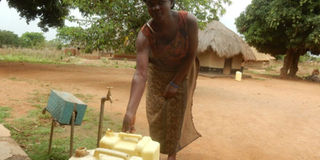Prime
Water scheme improves access to safe water

A woman draws water from a gravity-fed tap at Mbaro East, Nyaravur Sub-county in Nebbi District recently. PHOTO BY BILL OKETCH
NEBBI- More than 45,000 locals are upbeat about the new Nyarwodho gravity water flow scheme that has extended affordable water nearer to the households in the hitherto water stressed sub-counties.
The new government initiative that was handed over to the community in Nebbi in March is aimed at improving livelihoods of the people in the district.
Leaders say the project was established to benefit the four sub-counties of Nyaravur, Ndheu, Alwi and Kucwiny.
In the past, residents of Jopakeno Village in Nyaravur Sub-county used to trek about three kilometres to the neighbouring village to fetch water for domestic use.
Today, Ms Doreen Aciro, narrates how she fetches water from a public tap installed just about 20 metres from her home.
The price of water at public taps has also gone down. A 20-litre jerrycan of water that used to cost Shs200, currently goes for Shs100.
But more than 726 households already connected to the gravity flow scheme have an added advantage.
“Our children are no longer suffering from diarrhoea as was the case before and we believe they are healthy because we now consume clean water,” says Ms Immaculate Agenorwot, a resident.
Mr Festo Thubitho, Nyaravur’s senior assistant secretary, says more time is now dedicated to economic activities than searching for clean water.
How it works
Gravity water flow scheme is a relatively simple technology that takes advantage of altitude (highlands), availability of spring water, rivers or sufficient rain to capture clean water for human consumption.
The technology traps water from a source and transports it to users by gravity flow. Because it uses gravity to create the pressure to run the water, there is no need for pumps or any other form of energy to drive pressure to run the water.
The Nyarwodho gravity water scheme traps water from River Nyarwodho on the hill at the border with the Democratic Republic of Congo. The multi-billion water scheme is being constructed in three phases by the directorate of water development in the Ministry of Water and Environment.
Payment
All 725 connected and metered households are issued with water bills and given a grace period of two weeks, payment is then made through easy money terminal.
Easy money terminal is a machine with a simcard; the cashier goes and deposits float through mobile money.
Customers then pay their bills and it is automatically reflected on the Northern Umbrella of Water and Sanitation (NUWS)’s account after which a receipt is immediately printed and given to the customer. This is very convenient for the customers because one does not need to move very long distances to access banks and make payments.
The cashier also does not keep a lot of cash with them since they keep depositing it on the system through mobile money.
NUWS, a government agency responsible for maintenance, operation and system expansion of Nyarwodho, always dialogues with their clients to ensure they service their bills.
So far, the agency’s communications officer, Ms Brenda Akao, says no household has since been disconnected since they know they are dealing with the poor.
“If you embark on massive disconnections you end up disconnecting almost half the beneficiaries thus killing government intentions in line with the Sustainable Development Goal 6 (clean water and sanitation for all people),” she says.
The objective of the project is to improve safe water coverage in the Alwi Dry Corridor in Jonam County as well as selected settlements and rural growth centres in Padyere County. Alwi is one of the areas that have been suffering from water scarcity in Nebbi District for years.
The first completed Phase One was fully financed by the government of Uganda to a tune of Shs25.7 billion.
Challenges
The capital costs (one-time expenses incurred on the construction) of gravity-fed schemes are, on average, higher than the costs of schemes that obtain water from underground sources, according to experts.
The biggest cost in such water schemes tends to be the construction of the tanks and pipes.
The NUWS has, however, downplayed such fears.
The manager of NUWS, Mr Pierre Rwaka, says: “We shall move slowly, make fewer mistakes and score higher marks. We are going to score higher marks through system expansion.” The Ministry of Water and Environment estimates that 196 water points in Nebbi have been non-functional for over five years and are considered abandoned.
The ministry says the reasons for the non-functionality include, technical breakdown, water quality, alternatives nearby, low yield and vandalism.
The Poverty Status Report 2014 estimates that 19.7 per cent of Ugandans are poor and unable to pay for piped water required for household use. Additionally, households earning a monthly income of less than Shs500, 000 and are connected to piped water supply struggle to pay their monthly water bills.
What next?
Plan: After the completion of the second and third phase, more than 85,000 people in nine sub counties in Nebbi and Pakwach are expected to access safe water. The principal engineer, Mr James Sseguya, told this newspaper recently that the Ministry of Water and Environment has already secured money from the African Development Bank to fund the implementation of Phase Two of the gravity water flow scheme in Nebbi.
The second phase of the scheme will cover the sub counties of Pakwach, Panyango, and Ageno. Today, Nebbi has 906 domestic water points, which serve a total of 214,948 people of who 205,616 are in rural areas.
Access: Today, Nebbi has 906 domestic water points, which serve a total of 214,948 people of who 205,616 are in rural areas. The access rates in Nebbi vary from 53 per cent in Panyimur Sub-county to 95 per cent in Nebbi Sub-county.
The current water supply coverage for Nebbi stands at 74 per cent, according to Uganda Water Atlas website of the Ministry of Water and Environment.




